MIANOWEK, Poland – Lucien was a young boy in 1941 when the Nazis murdered 5,000 Jews near his home in the Polish countryside and left their bodies in a Soviet anti-tank ditch.
“For two weeks there were some killings and executions nearby…[the Nazis] started the shootings in the morning but it lasted the whole day,” he recalled. “The Jews were driven by trucks – there was this sort of column, at the beginning of it, there was a black car, and then there [were] trucks.”
The killing was likely done with machine guns, and given the time span, Lucien suspects that more than 5,000 Jews were killed, though that is the official body count attributed to this particular site.
“The local [Polish] villagers were forced to bury their bodies, but they covered [them] only with a [thin] layer of sand,” he said. “You could actually see the blood near those pits.”
At roughly five years old, the morbid curiosity of a child got the better of him.
“Sometimes I went to the execution sites…but my parents told me not to go there, especially because the bodies were decomposing in the pit so the smell was really horrible,” Lucien said.
Outside of the death camps, and the gas chambers, and the crematorium ovens, this was the Nazi approach to eradicating Jews: The Holocaust by Bullets. After the Nazis invaded the Soviet Union and Soviet-occupied Poland on June 22, 1941, Nazi forces rounded up Jews, transported them to ravines, pits, and forests, and shot them into these makeshift mass graves.
Perhaps the most well known of these shootings is the one at Babyn Yar, the ravine in Kyiv, Ukraine, in which roughly 33,000 Jews were murdered in two days.
But all across the countryside, including in small towns and villages like Mianowek, the Nazis transformed topography into death – killing anywhere from 1.5-2.5 million of the 6 million Jews who perished in the Holocaust.
In doing so, the Nazis left witnesses. Today, there are a handful of elderly non-Jews like Lucien who can tell firsthand what the Nazis did, and where they did it. The organization Yahad In-Unum, started by Father Patrick Desbois, a French priest, seeks out these witnesses to tell the often-overlooked story of Eastern European Jewry in the Holocaust.
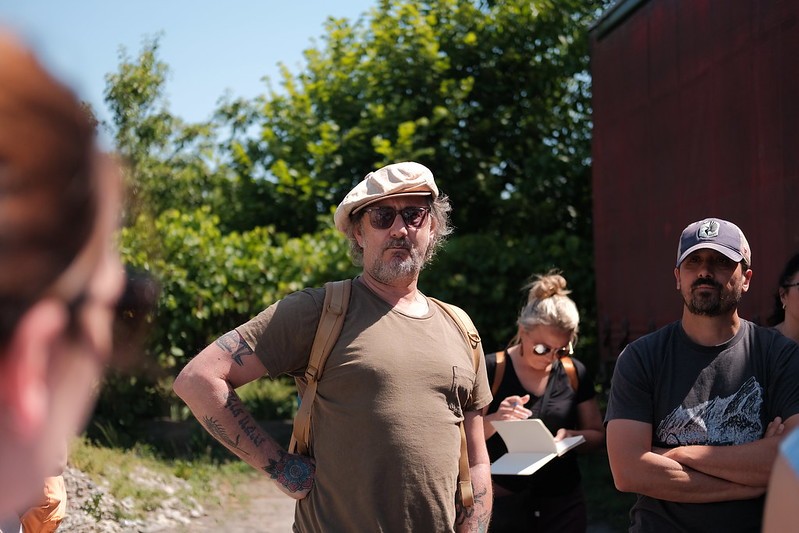
Adam Levy (center), a high school teacher in St. Paul, listening to the story of Czyzew’s Jews (Lev Gringauz/TC Jewfolk)
Brought to Lucien by Yahad-In Unum on June 21, 16 teachers listened carefully to his testimony in the afternoon heat, absorbing the rough childhood memories for almost 50 minutes.
“It reminds me of the importance of witness testimony,” said Adam Levy, a high school teacher in St. Paul, of meeting Lucien. Levy, who is Jewish, was one of the participants of the Power of Place, a Holocaust education trip to Europe run by Humanus Network and the Jewish Community Relations Council of Minnesota and the Dakotas.
“As time has gone on…I’ve become more interested in the hows and whys of the Third Reich and the perpetrators,” Levy said. But hearing from Lucien reminded Levy that “I need to continually refresh my connection to those that saw [the Holocaust], that are either witnesses or survivors.”
Czyzew
To understand the full scope of the mass shootings that happened in Mianowek, that morning the Power of Place group started its visit in the neighboring town of Czyzew.
Before the Holocaust, roughly 90% of Czyzew’s population – about 1,500 people – were Jewish. Jews lived all around this area: Yahad-In Unum’s head of research and education projects, Renata Masna, serving as a guide for the day, noted on the 90 minute bus ride from Warsaw that practically every town the bus drove past had a Jewish population before the Holocaust, from a few families to larger communities.
But here, the Jewish community – at least for a time – avoided the persecution that other Polish Jews faced after the Nazi invasion of Poland in 1939. That’s because this area was controlled, instead, by the Soviet Union, which collaborated with Nazi Germany to take over the country.
“You have the ghetto in Warsaw at the same time, but this Jewish community doesn’t live in a ghetto,” Masna said. “It’s under a different rule. It’s important to understand the difference between different areas, and then what happened, and why the Holocaust by Bullets [happened here]…when we are 14 kilometers from [the death camp] Treblinka.”
In Czyzew, as in so many parts of Europe, a once-vibrant Jewish community is most conspicuous in its absence. The Power of Place group’s first stop was in the main town square, right in front of the Catholic church that serves this area.
This plaza – now a parking lot – once held the central market where much of the Jewish community worked and gathered. The Jews lived near and around this plaza, but during WWII, bombs and fires destroyed most of the wooden homes they built.
Today, only one formerly-Jewish building is still standing here: A brick home now hosting a Polish family. It’s not clear exactly which Jewish family once lived in this building, but the locals remember that it was Jewish-owned.
“The non-Jews who live here knew where people lived, more or less,” Masna said. “So they pass the information [on], and then if there is one building that stays, it’s very particular. So it also attracts a lot of attention. And then that story keeps going with who the owner of the house is.”
Further away from the plaza, the group came to a stop in front of a feed store in a brick building. Once, observant Jewish families gathered here to pray and sent their children here to learn. It was a synagogue, also serving as a school and an administrative center for the Jewish community.
Today, there is perhaps just one clearly visible sign of the building’s former life: On the easternmost wall, indents that show where the ark that held torah scrolls once stood.
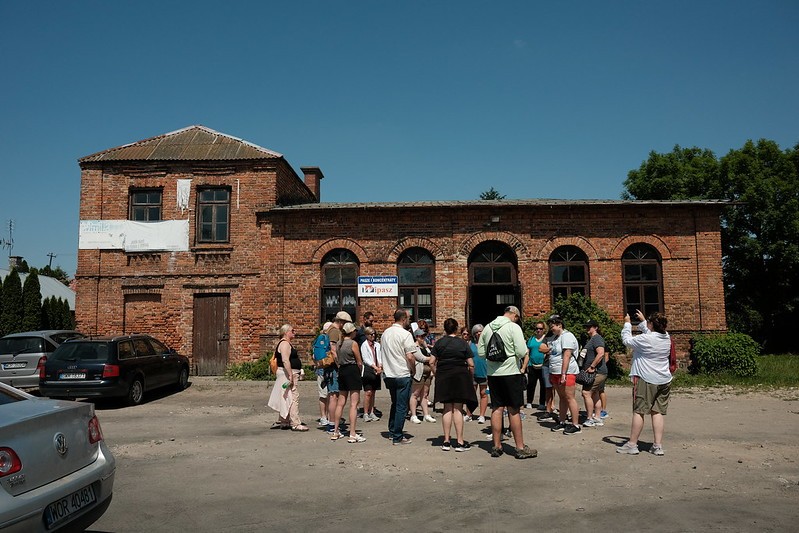
The Power of Place group stands in front of the synagogue-turned-feed store (Lev Gringauz/TC Jewfolk)
After the defeat of Nazi Germany, Poland enacted a variety of property restitution laws. But property could only be reclaimed by direct descendents of owners – excluding cousins and uncles, for example – and, after the near-total annihilation of Polish Jewry, there were few Jews left to do any reclaiming. Jews who did return to their homes after the war often faced rabid antisemitism, quickly driving them out.
Under communist rule, this synagogue was appropriated by the state, and today is owned by the local municipality.
The contrast between the building’s original purpose and its current use evoked complex emotions among the tour group. To Marlana Benzie-Lourey, a high school teacher in Pine County, Minn., it felt like the Jewish history here was being wilfully forgotten by the locals.
“I live where there are feed stores – I came around the corner, I knew right away, that’s a feed store,” Benzie-Lourey said. “The corn and the grit and oyster shells and whatever else you need for your chickens, they throw it in the back of your truck or your car. And it was a synagogue. It’s just hard to comprehend.”
A visit to what used to be the Jewish cemetery brought up similar feelings. With no gravestones in sight, there is just a forest and an old outer wall, with bits of trash and empty liquor bottles spread around in the undergrowth.
Later, at the train station, Masna walked through the rest of the story of Czyzew under Soviet occupation. Here, deportations did take place, but the Soviets targeted any locals they felt were too upper-class or a threat to Soviet control. That meant Poles and Jews alike were sent to Siberia, part of a policy of mass murder and displacement.
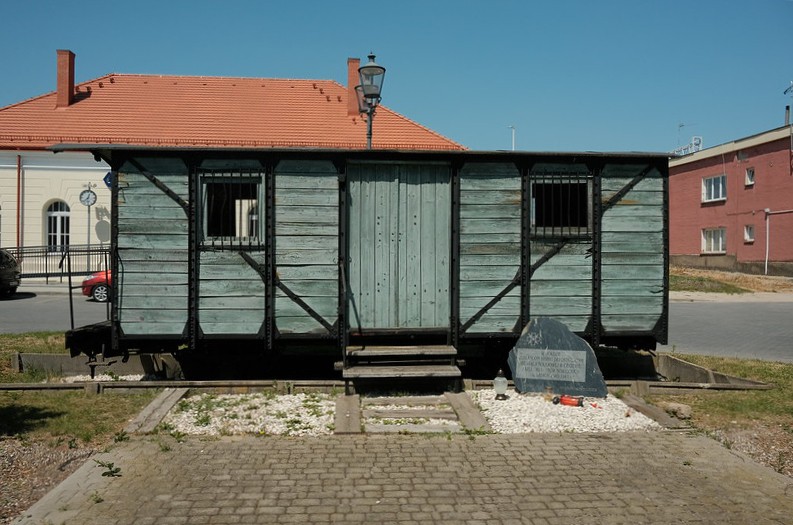
The memorial to local Poles deported by the Soviets to Siberia at the Czyzew train station (Lev Gringauz/TC Jewfolk)
Though the road to Siberia was extremely difficult, for Jewish families the Soviet deportation soon became a blessing in disguise. Away from home, the Nazis couldn’t murder them. That also meant these families only learned the fate of their community, and about the Holocaust, upon returning after WWII.
After the initial mass shootings by the Nazis, the Czyzew train station was used to transport some of the few remaining Jews in the area – kept for forced labor – to the Treblinka death camp.
There is a memorial outside of the train station. The plaque speaks only of the Soviet deportations to Siberia, and does not mention Jews at all. It’s a sign, perhaps, of the strained relationship Polish people often have with Holocaust memory in light of their own persecution under both Soviet and Nazi power.
“There are some people who want to compare and to put at the same level, the Soviet and the German occupation,” Masna said. “Which I think is very dangerous, if you do, to say, ‘Yes, the Jews, they were deported. They were killed. But [that also happened to us] – under a different rule, but we also suffered.’ It’s something that stays very strong today.”
But the memorial also signals the emptiness that today’s Polish Czyzew can’t shake; the void of a Jewish community eradicated in a matter of weeks, now, seemingly, a footnote to current inhabitants.
“Who is here to remember the Jewish past?” Masna said. “It’s very natural to remember your own families…but then, if there are no Jewish families left here, who will remember their story?”
Memory and trains
Having seen where the Jews of Czyzew once lived and worked, it was time to learn more about their murder at the hands of the Nazis. After lunch, the Power of Place group came to Mianowek.
In its investigations of killing sites, Yahad-In Unum first looks through various archives and finds information from memorial books, like one for Czyzew, put together by Holocaust survivors about their destroyed communities. Then, Yahad-In Unum sends investigators to villages and towns to ask who remembers WWII, and what happened to the Jews that once lived in the area. Out of the woodwork come people like Lucien, with many stories to tell.
Hearing Lucien speak was surreal. The Power of Place group sat in the old man’s yard, shaded from the midday sun, with the sound of farm animals in the background and his small dog enthusiastically strolling among the group asking for pets and butt pats.
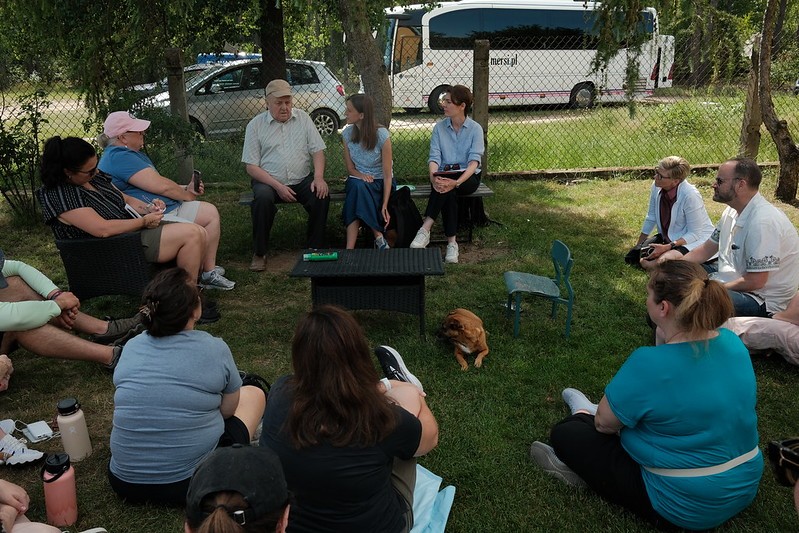
The Power of Place group in Lucien’s yard, listening to him speak (Lev Gringauz/TC Jewfolk)
Toward the front, Masna sat on the right side of a bench, her colleague Julia Machnowska sat in the middle, and Lucien sat on the left. Together, they showed the process of interviewing witnesses: Masna asked a question in English, Machnowska translated the question into Polish for Lucien, he would reply in Polish, and Machnowska would translate his response back to English for the group.
Lucien recounted what he knew: After the Nazi invasion on June 22, 1941, the Jews of Czyzew and other surrounding villages were rounded up and confined to a school building (by now, long since gone). In September 1941, they were then transported to a Soviet-dug anti-tank ditch nearby, shot into the ditch, and had their bodies roughly covered with earth by the local Poles at the command of the Nazis.
Later in November, there was another mass shooting on the same site, this time of a group of Jews selected by the Nazis for forced labor.
“I saw the column of people walking by – they had to sing some Nazi propaganda songs while walking,” Lucien said.
One hallmark of the Holocaust by Bullets as contrasted to the death camps: Jews did not undress or have their belongings systematically sorted out before being murdered. This meant that some Poles would come back to the execution sites to dig the corpses back up in the hopes of finding valuables.
The Nazis gathered some of the Jewish personal belongings they’d stolen at the school building and let the Polish villagers take what they wanted. As Lucien remembered, it could be a contentious process – sparking a pointed comment from one Nazi officer.
“People were even arguing over those belongings, and I remember that one of the Germans said that, ‘Right now, you’re arguing over Jewish belongings – and who would argue about your belongings when you would be killed?’” Lucien said.
For all the day’s focus on the Holocaust by Bullets, what Lucien witnessed and spoke about also drew beyond that. His family’s property is directly by a railroad line, and mere kilometers from where the death camp Treblinka was when it operated from 1942-43.
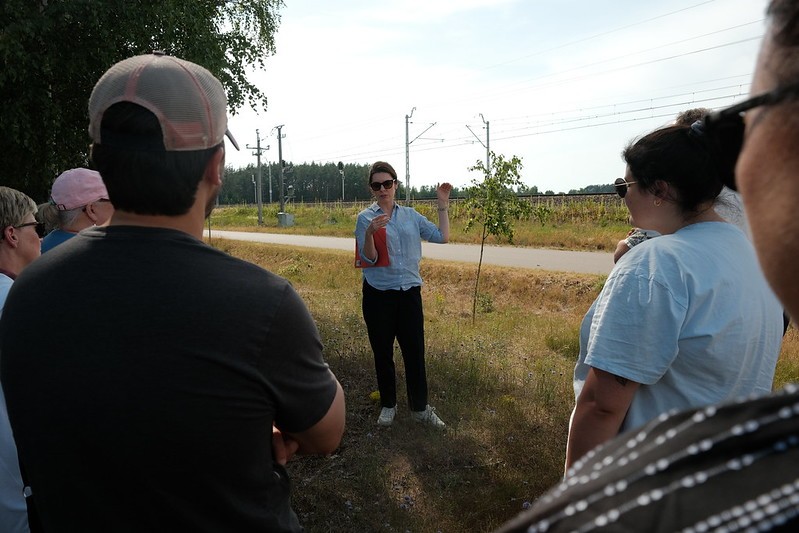
Renata Masna (center) stands at the edge of Lucien’s property while debriefing Lucien’s testimony with the group. On the other side of the train tracks behind Masna is the grave of the young Jewish woman Lucien spoke of – in his initial testimony, he showed Yahad-In Unum the exact spot, which is now saved as GPS coordinates (Lev Gringauz/TC Jewfolk)
He remembered the cattle cars passing by, 40 wagons per train, carrying Jews in the direction of Treblinka. “You could see, from those small windows, the heads of the people in those wagons,” Lucien said.
On the regular, Jews would precariously climb the steep walls of the wagons and jump to their freedom. Only it was rarely freedom: Many broke their limbs attempting to escape, and the Nazis kept a patrol behind the trains to catch would-be-escapees and shoot them.
Polish villagers were made to bury the bodies where they fell, all around and next to the railroad line. One time, Lucien remembers, 17 young Jews jumped to freedom, prompting the Nazis to stop the train and hunt each escapee down.
Another time, a young woman leapt from the train, but she, too, was caught, killed, and buried by the tracks directly next to Lucien’s property. Later, graverobbers dug up the woman’s body, so she had to be re-buried.
“One time, one of those fugitives from the trains came to our house,” Lucien said. “It was in the middle of winter, and he was quite cold. He asked if he can have a bit of heat from the stove, because he has very cold hands. We let him stay for a moment, but then we asked him to leave because it was very dangerous to help those fugitives. So he went, and I don’t know what happened with him.”
The railroad line is still in use today, and several commercial trains passed by the likely-too-numerous-to-count Jewish graves while Lucien spoke.
Later, when the Nazis started open-air cremating Jews murdered in the gas chambers in an attempt to hide their crimes, if “the wind was blowing in this direction, you could smell the burning bodies from Treblinka,” he said.
This was not Lucien’s first rodeo, as Yahad-In Unum had already interviewed him for its Czyzew investigation years before. Why he agreed to this re-enactment wasn’t clear. On the way out, several teachers – and this reporter, though with great trepidation – shook Lucien’s hand and thanked him for speaking with the group.
Now, it was time to see this Soviet anti-tank ditch; a dreadful climax to the day. The Jews of Czyzew were trucked there to die. This group took a tour bus.
Memorials and wild grass
In 1957, a group of Czyzew Holocaust survivors, now living in Israel, put out an appeal to other Jewish Czyzew-ites around the world to create a memorial book to their destroyed community.
“From generations of Jews and Yiddishkeit (Jewishness) there remains only enormous mass graves without gravestones, without the smallest memorial that should shout out to the world about the terrible tragedy that happened there,” the letter said. “On the huge mass graves wild grass is already growing. It covers and erases the traces of the horrible murders and they will be forgotten along with our entire past life in Czyzewo.”
According to Lucien, a stone carver from Warsaw came to Mianowek and placed memorials on the ditch-turned-mass grave – one of the memorials has a dateline of August, 1959, carved into it. Lucien’s son, born in 1958, remembers that when he was growing up, the memorials were there. But otherwise, no one knows who put up the memorials or who paid for them.
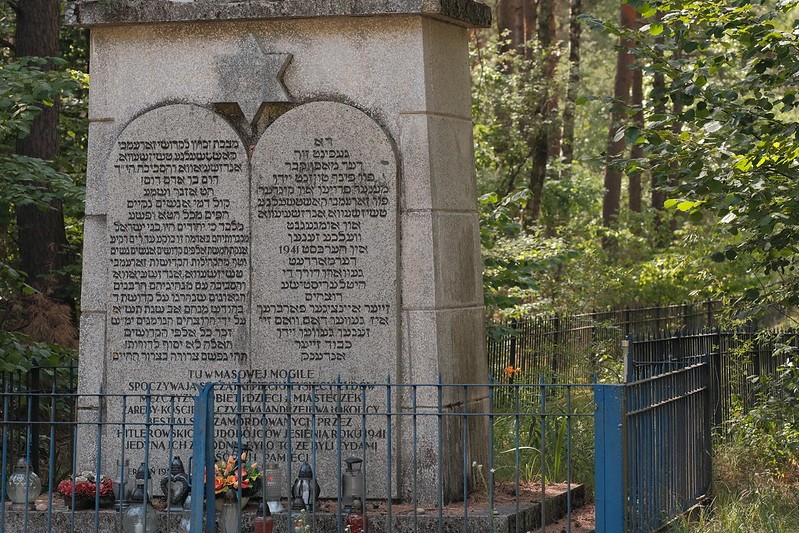
The roadside memorial at the mass grave in Mianowek. The fence surrounds the ditch where roughly 5,000 Jews from the surrounding area are buried (Lev Gringauz/TC Jewfolk)
So today, the cry of Czyzew’s Holocaust survivors does not go unheard; there is a sign here, visible to the world, telling the fate of their community. Around the perimeter of the mass grave is also a fence, to make clear the exact location of the ditch. At the memorial by the road, there are flowers and an array of memorial candles.
But the wild grass still grows here, and the ditch is now surrounded by a forest, with trash and liquor bottles littered around. Even with the memorials and fence, this place is tucked away – and, maybe not erased, but yes, covered.
After getting off the bus, the Power of Place group gathered around the memorial by the road as Masna filled out this story of murder, and had one of the teachers read from the recollection of one of the few survivors of this site.
The details were particularly gruesome, and left deeply disturbed this group of teachers, most of whom have their own children and families: When the day came to massacre the Jews confined in the school building, the Nazis first killed the children in front of their parents by smashing them against trees in the yard.
Parents, with their dead children, and the remaining Jews were loaded onto trucks, transported to Mianowek – where Lucien, as a young boy, saw them on the move – forced into the ditch, shot en masse, and buried. For days afterward, the ground moved, as not all had died immediately from the shooting.
There were a “small number of those who clawed their way out of the mass graves…and listened in the quiet to the rattle of our dying brothers during their last minutes,” wrote the editorial board of the Czyzew memorial book. “Some of them, in those terrible days, wandered through fields and forests, staying there overnight in the snow and cold.”
After gathering at the first memorial, the group had some time to wander the area. One of the teachers with a Jewish background was compelled by some unspoken force to walk around the fence of the ditch, and a few others, including this reporter, followed.
The ground was soft and squishy. An enormous anthill was stationed nearby, and legions of ants climbed up the teachers’ legs. In the fenced-off area, directly on the ditch, grew various sproutlings. The surrounding trees looked young and healthy.
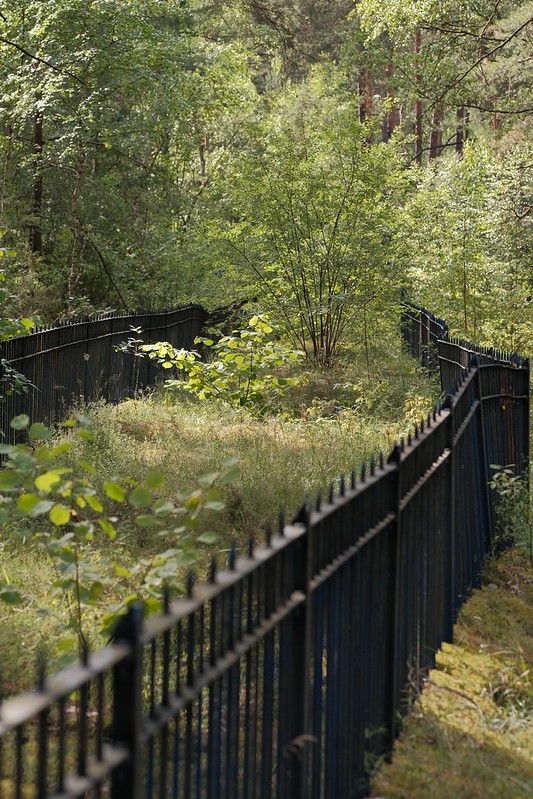
The wild grass and sproutlings growing on the mass grave (Lev Gringauz/TC Jewfolk)
The teachers were quiet – overwhelmed, it seemed, by the history they had learned and walked today. Just 83 years ago, this was where masses of people took their last breaths, in panic and terror, murdered simply for being Jewish. Here, the Jewish community of Czyzew came to an abrupt end. Now their blood feeds greenery.
Further into the woods, the group gathered around the second memorial stationed on the ditch. Together, they lit a memorial candle and recited a version of the Mourner’s Kaddish prayer that includes a recitation of various concentration and death camps.
Days later, the teachers were still processing what they had seen.
“It’s just unreal…standing next to a space, the sort of typography of murder,” said Adam Levy, from St. Paul. Being at the mass grave made him think about the brutal calculations the Nazis had to do for the killings.
“This conceptualizing, like, how are we going to put these bodies into a space…where you can basically see, from head to head, what it would have looked like to put 5,000 bodies into a space that’s six blocks long and 10 feet wide and three meters,” he said. “It just blows your mind that people did the geometry to make this happen.”
But for all the group learned about Czyzew’s Jews and the murder site in Mianowek, there were still questions left unanswered.
“I think one of the things that struck me the most, knowing that this organization Yahad-In Unum has compiled this extensive database on something like 3,500 sites so thoroughly – and yet this one site, they still didn’t know who committed these murders,” Levy said.
“I asked if it was the Einsatzgruppen [Nazi death squads], and [Masna] said no, because the Einsatzgruppen B that would have been here, already was in Russia by this time,” he said. “So it’s not clear if it was SS, or it was Polish auxiliaries, Ukrainians — who knows.”
Facing the lack of answers is an important part of being a teacher, Levy said, and of teaching the study of history.
“It just reminds me of the nature of this kind of work,” he said. “The kids always have questions, and it’s really important to say, ‘I don’t know, we don’t have all of the answers.’ It doesn’t lessen the intensity of what happened, it just means we don’t know everything.”
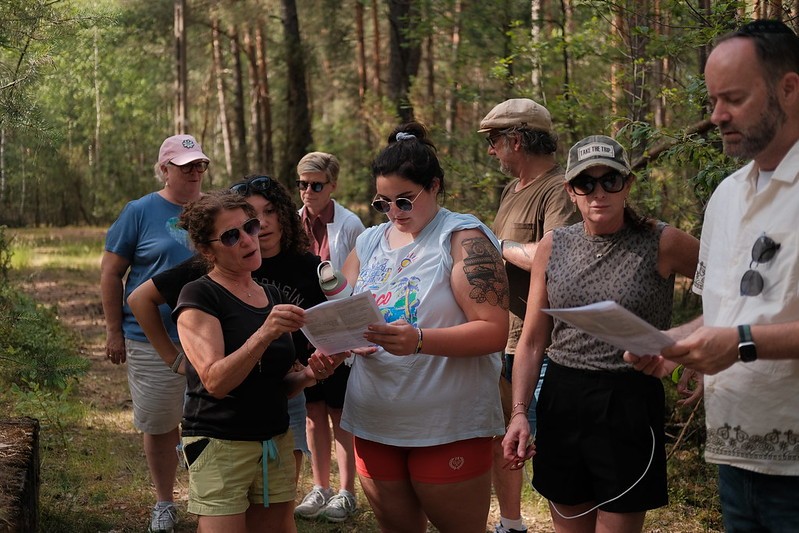
Participants of the Power of Place trip recite the Mourner’s Kaddish prayer at the second Mianowek mass grave memorial (Lev Gringauz/TC Jewfolk)
The trip to Czyzew and Mianowek fills out an important part of the history of the Holocaust that few tend to learn about.
“I think the public and kids in general, those that have some exposure to the Holocaust, tend to talk about Auschwitz and the extermination camps,” Levy said.
“What kids don’t realize is that [much of the mass killing] was done with bullets. And so being able to go to one of those sites, and to have that micro-historical tour of the life of these Jews, and what it must have been like, in their last few minutes, in this horrible catastrophe…is so powerful and profound.”

















1 comment